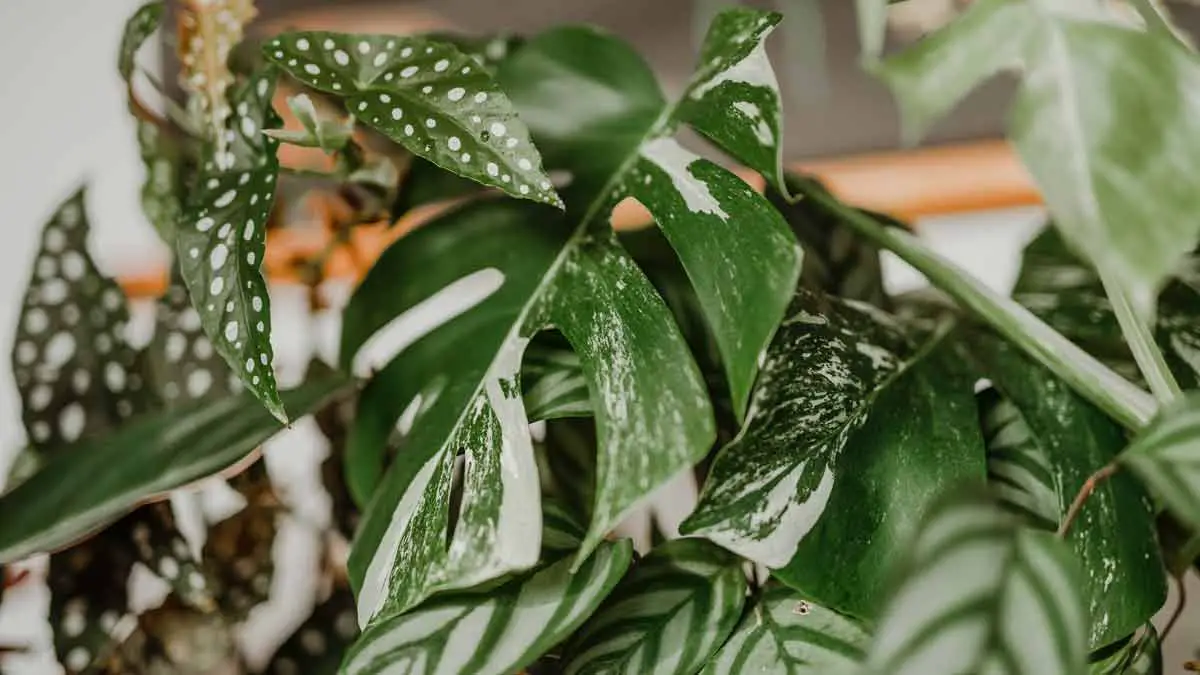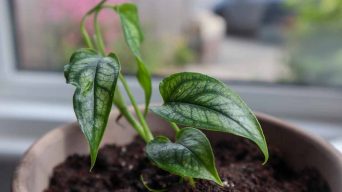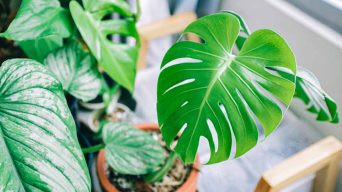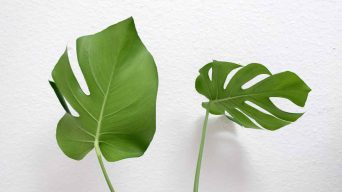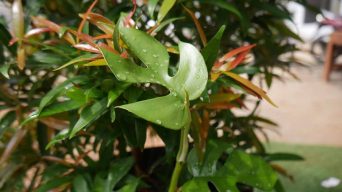To promote variegation in Monstera Variegata, place it in brighter light. Darker rooms result in more green leaves, while brighter rooms produce more variegated leaves. Random mutations, genetic mutations, or viral infections can cause variegation. But these processes are unpredictable and require a lot of patience.
Are you looking to add some color and life to your home? If so, you may have considered getting a monstera variegated plant.
Monsteras are beautiful plants that come in many varieties, including variegated ones. This type of Monstera has yellow and white leaves with unique patterns that create a stunning visual effect.
But can you make your own Monstera variegated?
In this guide, we’ll explain everything you need to know about making and caring for a variegated monstera, including pitfalls and risks to watch out for.
Understanding Variegation in Monstera Plants
Variegation is a term used to describe the appearance of plants with different colored leaves or sections.
In Monstera plants, this can be seen as white or yellow splashes on the foliage in an all-over marbled pattern or in certain parts of the leaf.
It’s a stunning look many people want to achieve in their Monstera plants, but it can be challenging.
Definition of Variegation
Variegation is a term used to describe the distinctive patterning found on specific plants.
The most common type of variegation is when parts of the leaves and stems are marked with different shades of green, yellow, white, or even pink.
This occurs when there is an interruption in chlorophyll production in certain areas of the plant.
As a result, these areas lack the green pigment that usually gives plants their color.
The cause for this interruption can be genetic or environmental.
Genetic variegation occurs when there is an alteration in one or more genes responsible for producing chlorophyll.
Environmental variegation can be caused by extreme temperatures or too much sunlight, which can cause stunted growth and discoloration in some parts of the plant.
Different Types Of Variegated Monstera Plants
There are several types of variegated Monstera plants, each with unique patterns and characteristics.
The most common varieties include:
- Monstera Albo Variegata: The rare and expensive Monstera Albo has creamy white splotches on its dark green leaves. It is commonly called the “Swiss Cheese Plant” due to its holes throughout the foliage.
- Monstera Aurea Variegata: This variety has bright yellow splotches on its dark green leaves and is often called “Golden Monstera” due to its golden hue.
- Monstera Sport Variegata: This variety has creamy white splotches on its dark green leaves with occasional streaks running through them, giving it an almost marbled look. It’s also known as “Mint Monstera” due to its minty hue.
- Monstera Thai Constellation: This variety has bright yellow splotches on its dark green leaves with occasional streaks running through them, giving it an almost starry look hence why it’s nicknamed “Thai Constellation”.
These varieties are all naturally occurring mutations and cannot be artificially created by humans, so they are highly sought after by collectors and enthusiasts alike!
Unfortunately, they are also quite rare, so if you’re lucky enough to find one, consider yourself very fortunate!
What Causes Variegation in Monstera Plants
Variegation in Monstera plants is an exciting and beautiful phenomenon.
While many may wonder if making their Monstera variegated plant is possible, the answer isn’t as simple as it seems.
Let’s take a look at what causes variegation in Monstera plants.
Mutations
Mutations are one of the most common causes of variegation in Monstera plants.
A mutation is when a gene changes, resulting in a different expression than what is typically seen in the species.
Mutations can be caused by environmental factors such as radiation or chemicals or inherited from parents.
Regarding Monstera plants, mutations are usually caused by environmental factors. They can result in white or yellow splotches on the leaves.
Viruses
Viruses are another cause of variegation in Monstera plants.
Some viruses, such as mosaic viruses, can cause discoloration of leaves due to their effects on plant cells.
These viruses can spread quickly through contact with other infected plants or contaminated soil or water sources.
While some viruses may cause minor discoloration, others may cause more severe damage that could lead to the death of the Monstera plant if not treated properly.
Chimerism
Chimerism is another possible cause of variegation in Monstera plants. It occurs when two different genetic lines merge during development to create a single organism with two distinct sets of DNA.
This type of variegation usually results in patches of different colors on the Monstera leaves and stems.
It is often referred to as “mosaic” variegation because it looks like a patchwork quilt made up of different colors and patterns.
Gene-splicing
Gene-splicing is a relatively new technique for creating genetically modified organisms (GMOs).
In this process, scientists insert genes from one organism into another organism to develop unique traits or characteristics that weren’t present before.
For example, scientists have used gene-splicing techniques to create GMO tomatoes that have been modified to resist certain types of diseases or pests that would typically harm them.
While this technique has not yet been used on Monstera plants, it could potentially induce variegation by inserting genes from other organisms that produce pigments differently than normal monsteras do naturally.
Can You Force a Monstera to Variegate
Several methods, such as chemical treatment, virus introduction, and radiation, can induce plant variegation.
Each method has its risks and drawbacks, so understanding them is essential before attempting them.
Chemical Treatment
One way to force variegation is to use chemicals, such as colchicine, that cause mutations in plant cells.
This method is not recommended because of its potential risk to the plant and you.
Colchicine is an alkaloid derived from the autumn crocus. It has been used for centuries as a medicine for gout and other ailments.
It has also been used to induce plant variegation since the late 19th century.
However, it can be toxic if ingested or absorbed through skin contact, so it should only be cautiously handled.
This method may not always produce the desired result due to unpredictable genetic factors.
Virus Introduction
Some viruses can cause variegation in plants.
However, this method is also not recommended because controlling the virus and harming the plant can be challenging.
Viruses are microscopic organisms that invade living cells and replicate themselves using their host’s resources.
They are highly contagious and can spread quickly through contact with infected plants or contaminated soil or water sources.
Introducing a virus into your Monstera could lead to serious health problems for your plant if not appropriately controlled.
Radiation
Exposing a plant to radiation can induce mutations that may result in variegation.
However, this method is also not recommended due to the potential risks of radiation exposure.
Radiation can cause genetic damage and potentially harm you and your Monstera plant.
Radiation exposure carries several risks, including cancer and other long-term health effects such as infertility or congenital disabilities in humans exposed over time.
Additionally, radiation exposure may damage or kill your Monstera if done incorrectly or without proper precautions taken beforehand.
It is also difficult to control the amount of radiation properly and predict which mutations will occur.
The Risks of Inducing Variegation in Your Monstera
Inducing variegation in a Monstera plant is not a guaranteed process; even if it is successful, it can come with risks.
While some gardeners may be willing to take the risk of inducing variegation in their plants, they should be aware of the potential consequences.
Your Monstera May Become Weak
The first risk is that the plant may become weak.
The process of inducing variegation can be stressful for your Monstera plant. It can weaken its natural defenses against diseases and pests.
This means that the plant may become more susceptible to disease and infestation, which could ultimately lead to its death.
Your Monstera May Die
The second risk is that the plant may die due to the process itself.
While this is rare, it does happen. Gardeners should know this possibility before attempting to induce variegation in their plants.
Variation Can Be Unstable
The third risk is that even if the process is successful, the variegation may not be stable and could disappear over time.
This means gardeners looking for a permanent solution should think twice before attempting to induce variegation in their plants.
Overall, while inducing variegation in a plant can be an exciting prospect for some gardeners, it also comes with risks that should not be taken lightly.
Gardeners should consider these risks before attempting to induce variegation in their plants and ensure they understand what they are getting into before taking action.
How To Encourage Variegation in Monstera Plants Safely
Can I make my Monstera variegated? It’s a question that many plant lovers have asked themselves.
After all, plant variegation is often seen as a desirable trait, and Monsteras are no exception.
But is it possible to make a Monstera variegated safely?
The answer is yes – but it’s not as simple as wishing for it to happen.
To encourage variegation in a Monstera, you must understand the different propagation methods available, the pruning techniques you can use, and the environmental factors that can help or hinder your efforts.
Propagation Methods
Regarding propagating Monsteras, there are three main methods: division, stem cutting, and tissue culture.
1. Propagation by Division
Division is when you split an existing plant into two or more parts. This method works best with mature plants that have multiple stems and roots.
It’s important to note that this method won’t necessarily produce variegated plants.
But if you already have a variegated plant, then division may be the best way to propagate it and increase your chances of getting more variegated offspring.
3. Propagation From Cuttings
Propagating Monstera plants from cuttings involves taking cuttings from an existing plant and rooting them in soil or water until they form new roots.
This method can be used on mature and immature plants. Still, again, it won’t guarantee that the resulting plants will be variegated.
4. Tissue Culture
Tissue culture involves taking small pieces of tissue from an existing plant and growing them in sterile conditions until they form new plants.
This method is more complex than the other two methods mentioned above. Still, it does offer one advantage: because the plant tissue samples are taken from existing plants, there’s a greater chance of producing variegated offspring if the parent plant is already variegated.
Pruning Methods
Pruning is another way to encourage variegation in Monsteras – but only if done correctly!
The most effective pruning technique for encouraging variegation is called “pinching”. This involves pinching off new growth at its base before it has had time to develop any chlorophyll (the green pigment found in leaves).
By doing this regularly over time, you can reduce the amount of chlorophyll produced by the plant – eventually leading to more pronounced variegation patterns in its leaves.
Another Monstera pruning technique that can help encourage variegation is simply removing non-variegated foliage from your plant regularly.
This will also reduce the amount of chlorophyll produced by your plant over time and help bring out any existing variegation patterns even further.
Environmental Factors
In addition to propagation and pruning techniques, environmental factors also play an essential role in encouraging variegation in Monsteras (and other plants).
Light
The most important factor here is light: these plants don’t produce much chlorophyll on their own due to their lack of pigment production.
They need plenty of bright indirect light for their leaves to remain vibrant and colorful without burning out or fading away too quickly.
Too much direct sunlight can be damaging for Monsteras.
Temperature and Humidity
In addition to light levels, temperature, and humidity levels should be kept within optimal ranges for maximum success, encouraging your Monstera’s natural patterning abilities!
Cooler temperatures and higher humidity levels will help keep the leaves looking their best and promote healthier growth.
Overall, while making a Monstera variegated isn’t something that happens overnight (or even within weeks), you can achieve beautiful results with patience and dedication!
By understanding how propagation methods work alongside pruning techniques and environmental factors such as light levels – you’ll be well on your way toward creating stunningly unique specimens with beautiful leaf patterns!
Probability of Success
The overall success rate of making a monstera variegated depends on a few factors, including the method used for propagation and pruning and environmental factors such as light levels and humidity.
In general, tissue culture has the highest success rate for producing offspring with variegation – but even this method cannot guarantee that every plant produced will be variegated.
Propagating from cuttings and pruning techniques can help encourage variegation – but in the end, it just comes down to luck!
As such, it’s important to remember that there’s no guarantee of success when making a monstera variegated – but there’s also no harm in trying!
Final Thoughts
Making a monstera variegated is a challenging task, and it can take a lot of dedication, patience, and luck to achieve beautiful results.
However, with the proper methods and environmental factors, and a bit of luck, you can create something unique and special!

